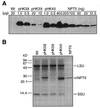Complementarity of the 16S rRNA penultimate stem with sequences downstream of the AUG destabilizes the plastid mRNAs
- PMID: 11160930
- PMCID: PMC29611
- DOI: 10.1093/nar/29.4.970
Complementarity of the 16S rRNA penultimate stem with sequences downstream of the AUG destabilizes the plastid mRNAs
Abstract
Escherichia coli mRNA translation is facilitated by sequences upstream and downstream of the initiation codon, called Shine-Dalgarno (SD) and downstream box (DB) sequences, respectively. In E.coli enhancing the complementarity between the DB sequences and the 16S rRNA penultimate stem resulted in increased protein accumulation without a significant affect on mRNA stability. The objective of this study was to test whether enhancing the complementarity of plastid mRNAs downstream of the AUG (downstream sequence or DS) with the 16S rRNA penultimate stem (anti-DS or ADS region) enhances protein accumulation. The test system was the tobacco plastid rRNA operon promoter fused with the E.coli phage T7 gene 10 (T7g10) 5'-untranslated region (5'-UTR) and DB region. Translation efficiency was tested by measuring neomycin phosphotransferase (NPTII) accumulation in tobacco chloroplasts. We report here that the phage T7g10 5'-UTR and DB region promotes accumulation of NPTII up to approximately 16% of total soluble leaf protein (TSP). Enhanced mRNA stability and an improved NPTII yield ( approximately 23% of TSP) was obtained from a construct in which the T7g10 5'-UTR was linked with the NPTII coding region via a NheI site. However, replacing the T7g10 DB region with the plastid DS sequence reduced NPTII and mRNA levels to 0.16 and 28%, respectively. Reduced NPTII accumulation is in part due to accelerated mRNA turnover.
Figures





Similar articles
-
Shine-Dalgarno Sequences Play an Essential Role in the Translation of Plastid mRNAs in Tobacco.Plant Cell. 2017 Dec;29(12):3085-3101. doi: 10.1105/tpc.17.00524. Epub 2017 Nov 13. Plant Cell. 2017. PMID: 29133466 Free PMC article.
-
The downstream box: an efficient and independent translation initiation signal in Escherichia coli.EMBO J. 1996 Feb 1;15(3):665-74. EMBO J. 1996. PMID: 8599950 Free PMC article.
-
Overexpression of the clpP 5'-untranslated region in a chimeric context causes a mutant phenotype, suggesting competition for a clpP-specific RNA maturation factor in tobacco chloroplasts.Plant Physiol. 2002 Aug;129(4):1600-6. doi: 10.1104/pp.004986. Plant Physiol. 2002. PMID: 12177472 Free PMC article.
-
Plastid mRNA translation.Methods Mol Biol. 2014;1132:73-91. doi: 10.1007/978-1-62703-995-6_4. Methods Mol Biol. 2014. PMID: 24599847 Review.
-
Untranslated regions of mRNAs.Genome Biol. 2002;3(3):REVIEWS0004. doi: 10.1186/gb-2002-3-3-reviews0004. Epub 2002 Feb 28. Genome Biol. 2002. PMID: 11897027 Free PMC article. Review.
Cited by
-
Boosting riboswitch efficiency by RNA amplification.Nucleic Acids Res. 2015 May 26;43(10):e66. doi: 10.1093/nar/gkv165. Epub 2015 Mar 30. Nucleic Acids Res. 2015. PMID: 25824954 Free PMC article.
-
Expression strategies for the efficient synthesis of antimicrobial peptides in plastids.Nat Commun. 2022 Oct 4;13(1):5856. doi: 10.1038/s41467-022-33516-1. Nat Commun. 2022. PMID: 36195597 Free PMC article.
-
Bacteriophage 5' untranslated regions for control of plastid transgene expression.Planta. 2013 Feb;237(2):517-27. doi: 10.1007/s00425-012-1770-3. Epub 2012 Sep 30. Planta. 2013. PMID: 23053542
-
Characterization of mercury bioremediation by transgenic bacteria expressing metallothionein and polyphosphate kinase.BMC Biotechnol. 2011 Aug 12;11:82. doi: 10.1186/1472-6750-11-82. BMC Biotechnol. 2011. PMID: 21838857 Free PMC article.
-
Engineering Chloroplasts for High-Level Constitutive or Inducible Transgene Expression.Methods Mol Biol. 2021;2317:77-94. doi: 10.1007/978-1-0716-1472-3_3. Methods Mol Biol. 2021. PMID: 34028763 Review.
References
-
- Etchegaray J.P. and Inouye,M. (1999) Translational enhancement by an element downstream of the initiation codon in Escherichia coli. J. Biol. Chem., 274, 10079–10085. - PubMed
-
- Hirose T., Kusumegi,T. and Sugiura,M. (1998) Translation of tobacco chloroplast rps14 mRNA depends on a Shine–Dalgarno-like sequence in the 5′-untranslated region but not on internal RNA editing in the coding region. FEBS Lett., 430, 257–260. - PubMed
Publication types
MeSH terms
Substances
LinkOut - more resources
Full Text Sources
Other Literature Sources
Miscellaneous

